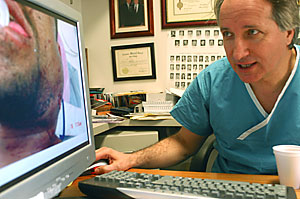 |
|
CASSIE TOMLIN/Arizona Daily Wildcat
|
UMC trauma surgeon Dr. Rifat Latifi displays a still photo from a teletrauma session he participated in earlier this semester. Specialists at University Medical Center have used the teletrauma system to assist doctors in Douglas with trauma patients since last November.
|
|
|
By Cassie Tomlin
Arizona Daily Wildcat
Friday, January 21, 2005
Print this
Doctors will now be able to save the lives of people in rural Arizona hospitals with virtual assistance from University Medical Center surgeons thanks to "teletrauma," a newly implemented videoconferencing software system.
UMC installed the two-way audio and video system in November, connecting a computer in a small room of the trauma ward with a computer in the emergency room at Southern Arizona Medical Center in Douglas, 120 miles southeast of Tucson, on the Arizona-Mexico border.
Teletrauma allows the specialists at UMC, southern Arizona's only level-one trauma center, to see and communicate with the patient and doctors in the SAMC Emergency Room. UMC's level-one status labels them the highest level of care in the area, as they are most equipped to handle severe trauma cases.
The surgeons can examine the patient's X-rays and monitor their vital signs, enabling them to make decisions and guide SAMC physicians through procedures demanding critical timeliness.
On Nov. 21, the system was used for the first time and helped save the life of an 18-month-old girl injured in a car accident that killed three adults. The child was comatose and suffered multiple fractures and head lacerations.
She had lost more than one-third of her blood when the SAMC emergency room doctor connected with UMC trauma surgeon Dr. Rifat Latifi three hours after the accident, said Latifi.
Latifi said he advised the ER doctor in taking several steps necessary to stabilize the patient before she was flown by helicopter to UMC.
The girl was operated on, recovered and was released to her home in Agua Prieta, Mexico, Latifi said.
"It's a helpful tool in a rural area where we're limited," said Debra Thornby, SAMC ER manager. "It's invaluable to have consultants at your fingertips."
The teletrauma system is an extension of the Arizona Telemedicine Program, which connects UMC to 131 rural hospitals and clinics in the state regarding every field from radiology to dermatology, Latifi said.
Latifi, the program's associate director of Telesurgery and International Affairs, said he pioneered telemedicine in Kosovo before he came to UMC two years ago and promised to bring teletrauma to Tucson.
Arizona is one of first states to use the teletrauma system, which began in Vermont in 2001.
UMC and Douglas borrow cameras and software, the equipment needed to perform teletraumas, from Visual Communications Network Inc., Latifi said.
Latifi called the system a "vital life-saving tool" and said within a year he hopes to connect teletrauma systems to Nogales, Bisbee, Sierra Vista, Benson, Safford and eventually every other rural town in Arizona.
He said he also hopes UMC will soon have a trauma surgeon on call solely for teletrauma cases.
Latifi said he is currently assisting with many disasters which could have been prevented had there been more teletrauma systems in the state.
In one case, a woman suffering from a flesh-eating disease may die because her case was not initially managed to the best of standards, Latifi said.
Latifi said complications leading to death could have been prevented if the hospital were equipped with the teletrauma system.
"If they had a $99 camera, it would all be OK," he said.
SAMC and UMC have used the system about 10 times since the rescue, the last time being Jan. 5 when a man in Douglas suffered facial lacerations after a car fell on his head.
Latifi determined from the man's CAT scan that since he had no brain injuries, he should be stabilized and brought to Tucson by ambulance, saving about $10,000 on a helicopter ride.
The teletrauma program is incredibly inexpensive compared to the cost of transporting patients to UMC, Latifi said.
Latifi said a large majority of level-one trauma centers' patients are transferred from other regions, many of them unnecessarily.
Teletrauma eliminates such futile procedures, by allowing doctors to gauge exactly what is needed to treat the patient, which may not ultimately include transporting them to UMC.
Latifi said he hopes in the future teletrauma systems in hospitals will be as common as telephones.
"It should be everywhere in the world," he said. "It is my goal for everyone to have access to the best possible care. It is the first right."
